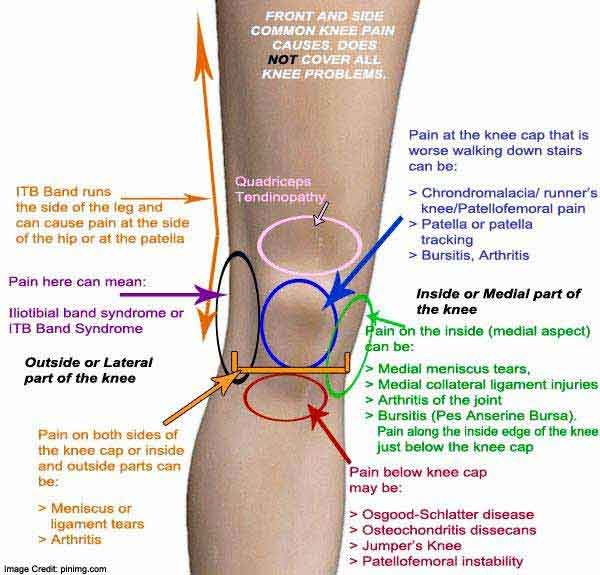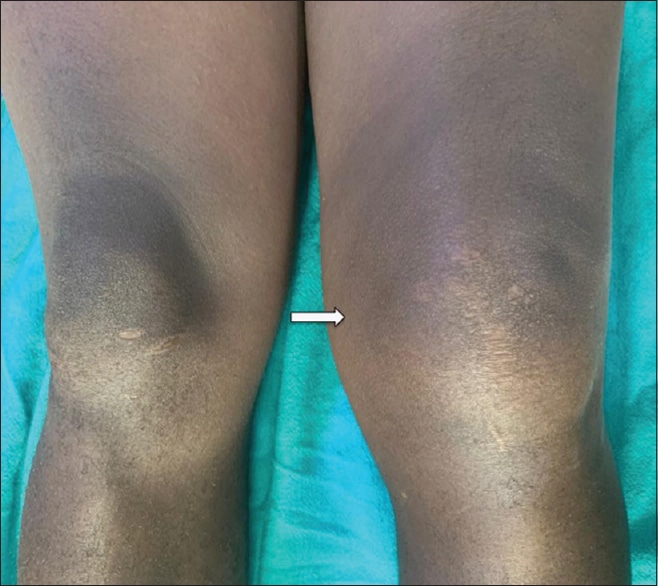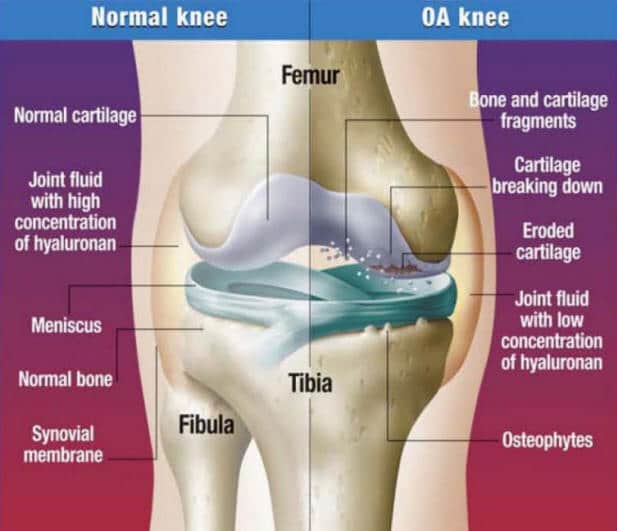Can Osteoarthritis Be Prevented
You can reduce your risk of developing osteoarthritis by avoiding significant damage or overuse of a joint. Maintaining a healthy weight will make osteoarthritis easier to manage if it develops in a weight-bearing joint, such as the knees, hips or feet.
Be careful of any product or treatment that claims to prevent osteoarthritis completely check with your doctor or pharmacist before taking any medication or supplement.
Is Surgery Used To Treat Knee Osteoarthritis
If your doctor wants to treat the osteoarthritis in the knee with surgery, the options are arthroscopy, osteotomy, and arthroplasty.
- Arthroscopy uses a small telescope and other small instruments. The surgery is performed through small incisions. The surgeon uses the arthroscope to see into the joint space. Once there, the surgeon can remove damaged cartilage or loose particles, clean the bone surface, and repair other types of tissue if those damages are discovered. The procedure is often used on younger patients in order to delay more serious surgery.
- An osteotomy is a procedure that aims to make the knee alignment better by changing the shape of the bones. This type of surgery may be recommended if you have damage primarily in one area of the knee. It might also be recommended if you have broken your knee and it has not healed well. An osteotomy is not permanent, and further surgery may be necessary later on.
- Joint replacement surgery, or arthroplasty, is a surgical procedure in which joints are replaced with artificial parts made from metals or plastic. The replacement could involve one side of the knee or the entire knee. Joint replacement surgery is usually reserved for people over age 50 with severe osteoarthritis. The surgery may need to be repeated later if the prosthetic joint wears out after several years. But with today’s modern advancements, most new joints will last over 20 years. The surgery has risks, but the results are generally very good.
Risk Factors For A Swollen Knee
- Being overweight or obese your knees are weight-bearing so any excess weight puts more strain on them, which can damage your knee joint over time obesity also increases the risk of osteoarthritis, which is a common cause of a swollen knees
- Playing certain sports if you take part in sports that involve pivoting, rotating or twisting your knees, youre at greater risk of knee injuries, which cause swelling
- Your age your risk increases as you get older
Dont Miss: Flying After Knee Replacement Surgery
Don’t Miss: Does Glucosamine Work For Arthritis
Impacts Of Psoriatic Arthritis In The Knees
PsA tends to be asymmetric, meaning different joints on either side of the body are affected . Symptoms in the knees can be mild and develop slowly or arise suddenly and severely. Arthritis usually follows the appearance of psoriasis on the skin. In addition to pain, swelling, and stiffness in the knee joints, PsA can lead to enthesitis and peripheral arthritis.
Recommended Reading: Knee Brace Support Meniscus
What Causes Bursitis In The Knee

To understand what causes knee bursitis, it is helpful to know more about the prepatellar bursa and bursae in general:
- A bursa is a thin, slippery, fluid-filled sac that serves as both a cushion and a lubricant between kneecap and skin.
- The prepatellar bursa is normally just 0.1 inch thickabout the thickness of 2 quarters stacked on top of each otherand 1.5 inches in diameter.2
- When inflamed, a bursas normally thin lining thickens and produces excess fluid. The excess fluid collects in the bursa sac, causing it to swell.
- When the prepatellar bursa is inflamed, it fills with fluid, causing the front of the knee to look swollen.
There are many reasons a prepatellar bursa may become inflamed, such as repeated irritation, an injury, or an underlying inflammatory condition. Repeated irritation from kneeling is the most common reason.
Recommended Reading: What Foods Should You Avoid When You Have Arthritis
What Is Arthritis Of The Knee
Arthritis is a disease that causes pain, swelling and stiffness in your joints. It can affect the largest and strongest joints in your body. Its common in knees. Arthritis of the knee can be a serious, debilitating disease.
Although there is no cure for knee arthritis, there are steps you can take that might ease your symptoms and potentially slow the progression of your disease.
What Is Osteoarthritis Of The Knee
Osteoarthritis of the knee happens when the cartilage in your knee joint breaks down, enabling the bones to rub together. The friction makes your knees hurt, become stiff and sometimes swell. While osteoarthritis in the knee cant be cured, there are many treatments to slow its progress and ease your symptoms. Surgery is an option for more severe forms of osteoarthritis.
Recommended Reading: How To Live With Arthritis In The Back
Youre Trying To Cope With Knee Osteoarthritis By Yourself
People with knee osteoarthritis often know that healthy lifestyle habits like exercise and weight control are recommended, but they arent implementing them, Dr. Garver says. His research, which was published in the October 2014 issue of The Journal of Rheumatology found that meeting with others who have osteoarthritis and sharing similar challenges can help motivate people to change their habits and add an exercise routine into their life.
Why Do Kids Get It
No one really knows what causes JIA. Something in the environment, like a virus, may trigger the disease in kids that already have certain genes that make it more likely for them to get it.
JIA is not contagious, so you cant catch it from someone else.
Arthritis is an autoimmune disease. An autoimmune disease means a persons immune system makes a mistake and attacks the bodys own tissues or organs. Normally, a kids immune system sends out white blood cells to protect the body and fight outside invaders like bacteria and viruses that can make a kid sick. But with an autoimmune disease like JIA, the immune system makes a mistake and attacks healthy cells.
Instead of recognizing the healthy cells and saying, Hi, nice to see you, the immune system thinks the healthy cells need to be destroyed and releases chemicals to fight the healthy cells. The chemicals released by the immune system cause the pain and swelling that can happen with arthritis.
Read Also: Bathing After Knee Surgery
Also Check: How To Reduce Arthritis In Knees
Ways To Manage Your Knee Pain
Aggressive intervention is essential is slowing the onset of rheumatoid arthritis, wherever it strikes. Although it is unusual to affect your knee joints first, it is still important to recognise the swelling/ pain and get a definitive diagnosis from your doctor. From there you have a number of options for managing the pain in your knee and preventing further erosion of your joints
1. NSAIDs . As the name suggests, these are designed to reduce the inflammation in your knee and increase its mobility. Common examples include Ibuprofen. This is likely only to be a short-term course, due to considerable side effects, particularly with long-term use.
2. DMARDs . These are used specifically to prevent further damage to your joints. They work by decreasing the cells that cause inflammation in the blood, therefore reducing the cause of joint damage. Examples include Ciclosporin and Methotrexate.
3. A Range Of Directly Injected Steroids Where Appropriate. Injected straight in to the knee joint, they can be used to reduce the inflammation. It is most likely your doctor will select from a range of corticosteroids to inject directly in to the joint spaces.
5. Strict following of the RICE technique Rest, Ice, Compression, Elevation. In other words, plan your days to ensure regular periods of rest, use ice whenever convenient to reduce the inflammation, Compress wherever possible to provide support and elevate when relaxing to rest and strong blood flow.
Home Remedies And Medical Options
Options include:
Experts say that people who play an active role in managing their OA, for example, are likely to see a more positive outcome. You can do so by learning about arthritis, becoming aware of what makes symptoms better or worse, and making decisions with your doctor.
Discover exercises to strengthen the knee muscles.
Recommended Reading: Can Psoriatic Arthritis Cause Muscle Spasms
What Is Water On The Knee
Water on the knee is a result of your bodys natural efforts to protect itself. When you injure your knee joint causing irritation and inflammation, your body produces extra joint fluid to cushion and lubricate your joints.
The extra fluid causes:
You wont be able to put pressure on your knee. Fluid on the knee can also limit your mobility and make it painful to go up and downstairs, kneel, or squat.
Buckling Knees And Popping Sounds

Knees can eventually start to buckle or give way once the knee joint becomes so bad that it causes the knee to be unstable. Tendons, which connect muscle to bone, can also become damaged and affect the knees stability.
When youve lost a certain amount of cartilage in your knee, you may feel a kind of grinding or hear a popping sound when you try to straighten or bend your knee. Both RA and OA can cause this kind of cartilage damage.
You May Like: How Long Does It Take For Arthritis To Develop
Lyme False Negatives And False Positives
The tests have been criticized by some for showing false negatives during the early stages of Lyme. But at the point where Lyme arthritis comes along, those tests should definitely be positive, says Dr. Lewandowski.
False positive Lyme test results can also throw a wrench into a Lyme arthritis diagnosis. This is when the test says you have Lyme disease but you actually dont.
In patients who have infectious mononucleosis or test positive for an antibody called rheumatoid factor , those other conditions could cross-react with the Western blot test and make it look like you have Lyme when its actually something else, according to a study in Pediatric Rheumatology. RF is associated with rheumatoid arthritis, so theres a chance that rheumatoid arthritis could be the real root of the joint pain.
However, rheumatoid arthritis tends to be symmetric, but Lyme arthritis rarely is, which could be a sign that it isnt Lyme after all.
If antibiotics for Lyme treatment dont seem to be working, a doctor can test fluids from the knee for signs of Lyme, says Dr. Law. A negative test would indicate the Lyme has cleared out and something else is causing the pain.
In rare instances, the initial Lyme infection can trigger a separate autoimmune condition, adds Dr. Lewandowski. In that case, the antibiotics should be dropped in favor of a new treatment plan such as anti-inflammatory drugs.
Donât Miss: Lock Knee Joint
Are There Complications Of Osteoarthritis
For many people, living with osteoarthritis will not cause major problems. However, complications that may arise from severe osteoarthritis include:
- deformity due to swelling of the joint
- poor sleep due to pain
- reduced ability to exercise
- restrictions performing daily tasks
As osteoarthritis is a long-term condition, you may feel anxious, frustrated or upset about how it is affecting your life. Talk with your doctor or a friend you trust if you need help and support.
Recommended Reading: What Foods To Stay Away From With Arthritis
Can Arthritis In Knee Cause Leg Swelling
. Inflammation can occur in many spots around the knee and cause pain and swelling. Knee Arthritis. Swelling. cause increased pressure and/or leg swelling
The commonest manifestation is in the region below the knee. calves or thighs. Leg swelling can result either from fluid build-up or from inflammation in injured or diseased tissues or joints. Many of the causes of leg.
Eating high-fat, high-carb meals can cause joint problems and arthritis. with 20 per cent saturated fats produced.
What You Should Know About Leg. Several diseases and conditions can cause leg pain, including arthritis. Compartment syndrome develops when swelling or.
How to Prevent and Treat Arthritis | Family Circle In fact, it’s estimated that almost 50% of us will be dealing with some form of it by the time we turn 65. The first signs are typically puffy or swollen knees and legs that hurt when straightened or bent. The pain is caused by bone rubbing on bone after cartilage has broken down. Early symptoms are.
Golfer Tiger Woods won the U.S. Open earlier this week while grimacing with pain due to a knee injury. upper and lower leg bones in a crisscross shape in the middle of the knee joint. They give the knee stability. ACL tears, which.
Knee Arthritis. 43 million Americans have some type of arthritis. Arthritis is damage and thinning of joint cartilage. Cartilage is found on the ends of almost all bones.
Do I Need Total Joint Replacement
The orthopedic surgeon will decide based on the knee condition and the severity of the symptoms. Usually, surgery is needed if medical treatments fail, knee arthritis impacts daily life, and the knee is deformed. Most patients who do total joint replacement are older. However, TJR has shown positive outcomes in any age group. Many patients who undergo surgery have a reduction in knee pain and can perform daily activities much better.
Also Check: What Are Some Symptoms Of Arthritis
What Other Symptoms Are Linked With Knee Joint Pain
Symptoms of osteoarthritis of the knee are generally limited to the joint itself, whereas inflammatory arthritis causes a wider array of issues. Unlike OA, inflammatory arthritis is a systemic disease, which means it affects the whole body, says CreakyJoints Medical Advisor Vinicius Domingues, MD, a rheumatologist in Daytona Beach, Florida.
In fact, it would be less common for someone with a form of inflammatory arthritis to experience pain in just one knee. Thats because symptoms are usually symmetrical whats more, inflammatory arthritis symptoms usually dont start in the knee.
For example, rheumatoid arthritis generally strikes the small joints in the fingers and toes first, while someone with ankylosing spondylitis is more likely to complain of low back and buttock pain, with knee arthritis pain developing later.
Depending on the type of inflammatory arthritis you have, you may experience other symptoms beyond knee joint pain. People with psoriatic arthritis exhibit the telltale scaly rash and plaques of psoriasis eye inflammation can be a problem for those with psoriatic arthritis as well as ankylosing spondylitis, and people with rheumatoid arthritis may experience weight loss and fevers.
Articles On Knee Osteoarthritis
While age is a major risk factor for osteoarthritis of the knee, young people can get it, too. For some individuals, it may be hereditary. For others, osteoarthritis of the knee can result from injury or infection or even from being overweight. Here are answers to your questions about knee osteoarthritis, including how it’s treated and what you can do at home to ease the pain.
Also Check: What’s The Best Pain Reliever For Arthritis
Causes Of Reactive Arthritis
Typically, reactive arthritis is caused by a sexually transmitted infection , such as chlamydia, or an infection of the bowel, such as food poisoning.
You may also develop reactive arthritis if you, or someone close to you, has recently had glandular fever or slapped cheek syndrome.
The body’s immune system seems to overreact to the infection and starts attacking healthy tissue, causing it to become inflamed. But the exact reason for this is unknown.
People who have a gene called HLA-B27 are much more likely to develop reactive arthritis than those who don’t, but it’s unclear why.
Nonsurgical Treatment For Knee Arthritis

When a patient is ready to address their arthritis, treatment will first be approached from a nonsurgical standpoint. Our orthopedic doctors in Bend have a number of different nonsurgical options they will first discuss with their patients and have them try before considering surgical treatment options.
- Some of these nonsurgical recommendations could help slow the progression of arthritis in the knee:
- Minimize activities that aggravate the condition, such as climbing stairs.
- Switching from high-impact activities to lower impact activities will put less stress on your knee.
- Losing weight can reduce stress on the knee joint, resulting in less pain and increased function.
Other nonsurgical options to help ease arthritis pain:
Don’t Miss: Is Stretching Good For Arthritis
Youre Not Losing Weight If You Need To Which Could Stress Your Knee Joint
The more you weigh, the more stress is placed on the knee joint, which can trigger an increase in pain, according to the American Academy of Orthopaedic Surgeons . Whats more, a study published in August 2017 in the journal Radiology found that when overweight and obese adults lost weight over a two-year period, they significantly slowed down their rate of knee cartilage degeneration.
You Arent Exercising Which Is Bad For Your Knees
It may seem counterintuitive to exercise if you have joint pain, but the Arthritis Foundation tells people to be active. The knee joint loves motion, says Brian Halpern, MD, a sports medicine physician with the Hospital for Special Surgery in New York City and author of The Knee Crisis Handbook. The challenge is to find the best types of activities for you. Dr. Halpern recommends bicycling, swimming, and elliptical trainers, as well as strengthening exercises that help muscles support the knee joint.
Don’t Miss: How To Slow Down Rheumatoid Arthritis